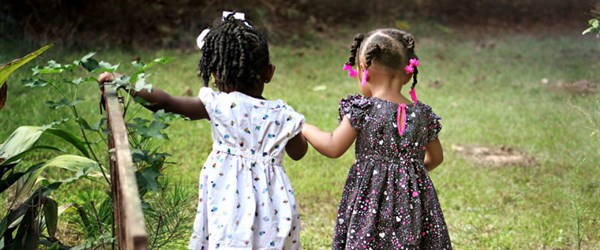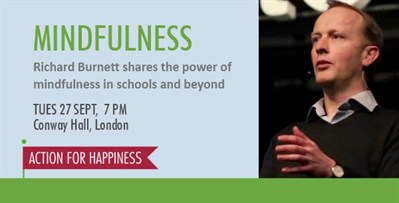Teaching Mindfulness to Children
13 Sep 2016 | Shamash Alidina

Do you wish you were taught mindfulness as a child? I do!
I never knew that thoughts were not facts. No one told me a
short exercise could leave me feeling relaxed and happy.
But how can you go about teaching mindfulness to a child? Here
are some key points and tips that may help you teach mindfulness to
children.
Mindfulness
fundamentals
Mindfulness is a present moment awareness with 'mindful
attitudes'. Different mindfulness teachers emphasise different
values, but for me, being kind is the most important. That's why I
call it kindfulness rather than mindfulness.
Here are some key attitudes of mindfulness:
- Present-moment awareness - being aware of any
of your senses or inner thoughts and emotions. It's the opposite of
being lost in your thoughts or multi-tasking.
- Kindness - learning to be nice and friendly to
yourself and others in thoughts, words and actions. Sometimes, it's
called compassion.
- Curiosity - being interested in the world
around us and within us. Ideally, you would also be cultivating a
sense of awe or wonder along with curiosity, which research shows
is very good for you too - making you happier and healthier.
- Allowing or acceptance - letting things be
instead of trying to change them, especially when it comes to
emotions and thoughts, and observing experiences instead of trying
to control or fight them. Mindfulness has roots in Buddhism, and
the Buddha essentially stated: To be happy, you need to let go of
control. Grasping and controlling is the root cause of suffering
and unhappiness.
Set a good
example
As you probably know, children learn a lot more from your
behaviour than from your words. Try these tips to help your child
be more mindful.
Practise mindfulness regularly
I know this is easier said than done. But you can't expect to
tell your child to be mindful if you're not very mindful yourself.
That won't work too well, I reckon.
BUT! Remember, mindfulness is more than just meditating all the
time. It's about being kind and forgiving of yourself and others.
Kindfulness is what you're really doing and sharing. Be kind to
yourself each time you accidently snap at your child. Don't beat
yourself up for not being the perfect teacher or parent. Treat
yourself as you'd treat a friend, and your self-compassion will
shine through to your child.
Schedule time to be present with your child
If you're super busy, it can be easy to forget to be present
with your child. If you run your life on a calendar or diary, use
it to schedule times when you can be mindful with your child.
Listen to them, talk to them, play games with them. See if you can
switch your phone off and have some quality time with your child
while having digital detox yourself. As you spend time with them
being mindful, they in turn will start being more present too.

Make it fun
Children are automatically attracted to anything fun. A bit like
me! Try these approaches when sharing mindfulness with your
child.
- Short meditations. When sharing meditations
with your child, keep them nice and short. Long meditations are not
fun for children. And if they associate mindfulness with boredom
rather than pleasure, they're less likely to engage in it. Even one
minute is a nice start.
- Connecting with senses. Think about creative
ways to get your child to connect with their senses. It could be
listening to music, playing in the sand, looking at and drawing a
tree, smelling different scents, tasting some food very slowly, or
feeling lovely textures. Mindfulness can be done in all sorts of
creative, artistic ways. Anything that gets your child out of their
head and into the conscious moment of now is mindfulness.
- Colouring in. Colouring is all the rage for
adults nowadays, but don't forget it can be great for children.
Some kids love it, so give them time to carefully colour some
positive images.
- Simply playing. Playtime is obviously very
good for children. I see playing as a key element of mindfulness.
In play, children are letting go and engaging in the present
moment. If you can let your child play in nature, they will have a
beautiful way of developing a more mindful brain. As I said
earlier, too much control is the cause of suffering, and letting go
leads to a happier life. The more you can let go and let your child
play, the more your child may pick up this subtle way of being and
be less controlling in their own life too.

Adapt for different
ages
Children of different ages need different approaches to
mindfulness.
Younger children-stories and games
I don't have exact ages here, but each child is different, and
if you know them, you'll know what they like. Stories are very
engaging for young children in particular. Find some 'mindful'
stories online or in books, and read them to your child. Ideally,
find a story which includes a little mindful exercise or some deep
breathing.
I mentioned games and fun activities earlier. What sorts of
games cultivate mindfulness? Here are a few games you can play with
your child:
- Play memory games. For example, have your child look at a tray
of objects while they try to memorise them, and then ask them to
recall the objects.
- Listen to the sound of a bell until it dissipates into
silence.
- Do 'spot the difference' exercises.
- Put a teddy bear on their belly, and ask them to watch their
teddy go up and down as they breathe.
- Let them colour.
- Teach them how to do origami.
- Teach them fun children's yoga poses described as different
animals.
- Sing and dance with them.
- Sleeping lions - This is where children have to be as still and
quiet as possible as they lie on the floor. That's great for young
children and fun for the adults to see, too!
Older children
Older children, teenagers and above, may start appreciating more
serious meditations. You could try getting them to listen to:
- Body scan meditation
- Awareness of breath meditation
- Short loving-kindness meditations
- Mountain or Lake meditations
You can get these audio tracks when you buy most books on
mindfulness, including mine. In fact, in my book Mindfulness for Dummies, there's a whole
chapter on teaching mindfulness to children. But try a few out
different audios, and pick a voice and guidance that works well for
your child.
In Conclusion
When teaching mindfulness to children, setting an example is
most important. Making it fun is key, especially for younger
children. Be creative so it's fun for you to share mindfulness in
different ways. If you're excited to share mindfulness, the young
child will sense that too.
Use nature to cultivate mindfulness-spend time in nature with
your child if possible. Even planting seeds in a pot is
valuable.
Finally, short meditations are an important skill to teach
children, so sharing some guided mindfulness exercises with them,
whether you do the guiding yourself or via audio, is a great
idea.
Do you know any other tips, resources or good ideas of
teaching mindfulness to children? Please share in the comments
below so we all learn together.

Find out more at our Mindfulness in Schools and Beyond event with
Richard Burnett from the Mindfulness in Schools Project, on Tuesday 27
September 2016 in London.
About Shamash Alidina

Shamash
Alidina is a mindfulness teacher, author and founder of the Museum of
Happiness. He is organising the Happier
World Conference in November 2016.